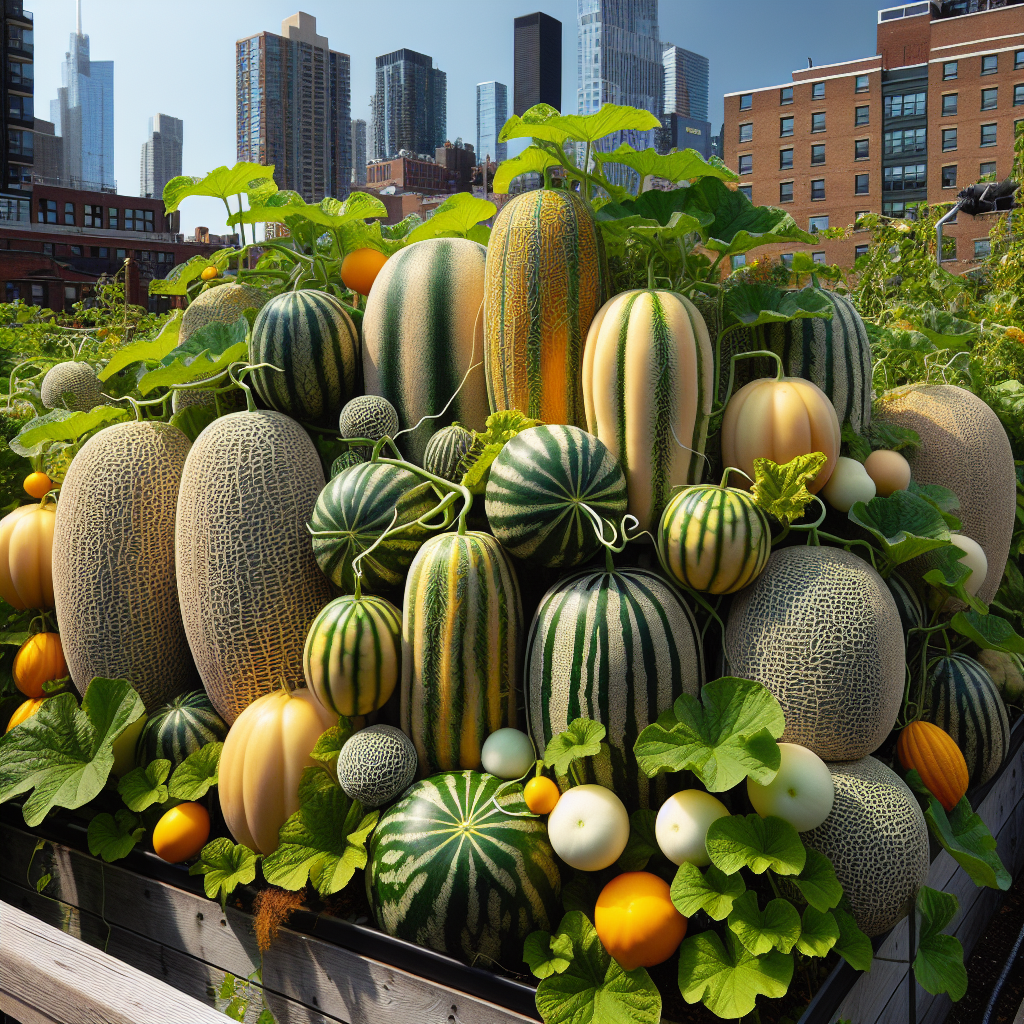
Key Takeaways
- Compact melon varieties like ‘Minnesota Midget’ and ‘Sugar Baby’ watermelon are perfect for urban gardens.
- Choose melon varieties with shorter growing seasons and high disease resistance for best results.
- Use large containers with proper drainage and support structures to grow melons in small spaces.
- Regular watering, full sunlight, and pollinator attraction are crucial for healthy melon growth.
- Quality seeds are key; purchase from reputable sources like Survival Essentials for diverse and robust varieties.
The Quest for Compact Growth
Urban gardening is a creative endeavor that transforms small spaces into lush, productive havens. With the right approach, even the coziest balcony or rooftop can yield an abundance of fresh, juicy melons. The trick lies in selecting varieties that not only flourish in limited space but also bring a burst of summer flavor to your table.
Flavors that Thrive in Limited Spaces
When space is at a premium, every plant counts. That’s why we focus on melon varieties that are not only compact but also packed with flavor. From the rich, sweet taste of ‘Honey Rock’ to the refreshing crispness of ‘Rocky Ford Green,’ there’s a melon for every palate—and every urban garden.
Choosing the Right Melon Varieties
Before you get your hands dirty, let’s dive into the world of melons to find the perfect match for your urban oasis. Each variety comes with its own set of characteristics, from size and growth habits to flavor and resilience against pests and diseases. Here are some top contenders that are making a splash in the urban gardening scene.
‘Minnesota Midget’: The Space Saver
The ‘Minnesota Midget’ is a true champion of compact growth. This cantaloupe variety reaches maturity quickly, usually within 60 to 70 days, and produces small, 4-inch fruits perfect for a single serving. The vines are short and manageable, which means they won’t overrun your limited space. Most importantly, the ‘Minnesota Midget’ is renowned for its sweet and rich flavor, which is why it’s a favorite among urban gardeners.
‘Sugar Baby’ Watermelon: Tiny But Tasty
Don’t let the name fool you; the ‘Sugar Baby’ watermelon packs a mighty punch in a small package. This variety is beloved for its dark green rind and sweet, red flesh. The fruits are petite, typically weighing in at 8 to 10 pounds, making them ideal for small gardens. Plus, ‘Sugar Baby’ vines are relatively short, so they won’t take over your space—just give them a sturdy trellis to climb, and you’re all set.
‘Charentais’: A French Favorite in Your Backyard
Besides that, for those who fancy a touch of European flair, the ‘Charentais’ melon is a must-try. This French heirloom variety is known for its smooth, gray-green skin and incredibly aromatic, orange flesh. Although it requires a bit more care and a slightly longer growing season, the exceptional taste of ‘Charentais’ melons is well worth the effort, especially when you’re craving a gourmet experience right from your garden.
‘Garden Baby’: Born for the Balcony Garden
And then there’s ‘Garden Baby’, a miniature melon that’s tailor-made for balcony gardens. These melons are not only adorable but also offer a deliciously sweet taste. Their vines are compact, and the fruits mature quickly, usually in less than 85 days. With ‘Garden Baby’, you can enjoy the full melon-growing experience without worrying about space.
Expert Tips for Urban Melon Cultivation
Now that you’ve selected your melon varieties, it’s time to focus on the nitty-gritty of urban melon cultivation. With the right care and attention, you can coax these sun-loving vines into producing luscious fruits, even amidst the hustle and bustle of city life.

Container Gardening Success with Melons
Container gardening is a game-changer for urban growers. It allows you to control the soil quality, manage water drainage, and even move your plants to chase the sun. For melons, you’ll need large containers—at least 18 inches deep and wide—to accommodate their root systems. Ensure each container has ample drainage holes to prevent waterlogged roots, which can spell disaster for your melons.
Ideal Soil Mixes for Urban Melons
Melons crave warm, well-draining soil rich in organic matter. A mix of potting soil, compost, and perlite or vermiculite will give your melon plants the perfect balance of nutrients, moisture, and aeration. Remember, melons are heavy feeders, so supplement your soil with a balanced, slow-release fertilizer to support their vigorous growth.
Maximizing Sun Exposure in the Concrete Jungle
Most melon varieties need full sun to thrive. In the urban jungle, that can be a challenge, but it’s not insurmountable. Position your containers in the sunniest spot available, typically a south-facing balcony or rooftop. If tall buildings cast long shadows, consider using reflective surfaces to bounce additional light onto your plants. The extra effort will pay off with sweeter, juicier melons.
Protecting Your Melons from Urban Pests

Even in the city, melons can attract unwanted visitors like aphids, cucumber beetles, and squash vine borers. Vigilance is key to keeping your melon patch pest-free.
Natural Pest Control Solutions
For a chemical-free approach, introduce beneficial insects like ladybugs or lacewings to your garden. They’ll happily munch on pesky aphids. You can also apply neem oil or insecticidal soap to manage outbreaks. Remember, the goal is to maintain a healthy ecosystem where your melons can flourish.
Keeping Critters at Bay: Secure Planting Techniques
To deter larger pests like squirrels or birds, physical barriers can be effective. Use netting to cover your melon plants or hang shiny objects nearby to scare birds away. For squirrels, a sprinkle of chili powder around your plants can be a non-harmful deterrent. And of course, keeping your garden tidy reduces hiding spots for critters.
Harvesting and Enjoying Your Urban Melons
After months of careful tending, nothing beats the satisfaction of harvesting your homegrown melons. But how do you know when they’re ready to pick?
Signs of Ripeness: When to Harvest
Look for a few telltale signs to ensure you’re picking your melons at the peak of ripeness. The stem should easily separate from the fruit, the skin should resist penetration when pressed, and you’ll often hear a hollow sound when you tap the melon. Additionally, the spot where the melon rests on the ground will turn from white to a creamy yellow as it ripens.
From Vine to Table: Savoring Your Success
Once harvested, chill your melons before serving to enhance their refreshing taste. Melons are versatile—enjoy them fresh, in fruit salads, or as part of savory dishes. The fruits of your labor will be a hit at summer barbecues or as a healthy snack for your family.
Where to Source Quality Melon Seeds
The foundation of any successful garden starts with high-quality seeds. To ensure a bountiful harvest, it’s essential to source your seeds from reputable suppliers who offer a wide range of varieties suited for urban gardening.
Survival Essentials: A Cornucopia of Melon Varieties
For a diverse selection of melon seeds, look no further than Survival Essentials. They offer an extensive collection of heirloom and non-GMO seeds, perfect for the urban gardener seeking robust and flavorful melons. Whether you’re after the sweetness of ‘Honey Rock’ or the novelty of ‘Garden Baby’, they’ve got you covered.
Seeking the highest quality seeds is not just about ensuring growth; it’s about guaranteeing the flavor and health of your melons. When shopping for seeds, pay close attention to the variety and its suitability for container growth. Seeds should be sourced from suppliers that offer heirloom and non-GMO options, as these are often more flavorful and adapted to organic growing conditions.
Seeking the Sweetest Seeds: Purchasing Tips
When it’s time to buy seeds, don’t just grab the first packet you see. Consider these tips for finding the best seeds for your urban garden:
- Check the variety: Ensure the seeds are suitable for container growing and have a short maturity time.
- Read reviews: Look for customer feedback on germination rates and plant health.
- Buy from specialists: Choose suppliers like Survival Essentials that focus on heirloom and non-GMO seeds.
- Look for freshness: Fresh seeds have higher germination rates, so check packaging dates.
FAQs
Let’s tackle some common questions to ensure you’re fully equipped to grow melons in your urban garden.
How do I know what size container to use for melon plants?
For most melon plants, you’ll need a container that’s at least 18 inches deep and wide. This size provides enough space for the roots to spread out and for the plant to stabilize as it grows. Remember, a sturdy container is also necessary to support the weight of the fruit.
Can I grow different melon varieties next to each other?
Yes, you can grow different melon varieties next to each other, but be aware of cross-pollination. If you’re saving seeds, cross-pollination can affect the purity of the varieties. For fruit production, it won’t cause issues in the current growing season.
What can I do if my melons aren’t sweet?
If your melons aren’t as sweet as you’d like, ensure they’re getting enough sunlight and heat, as these are crucial for sugar development. Also, avoid overwatering, as too much water can dilute the melons’ flavor. Let the soil dry out slightly between waterings.
How do I manage limited sunlight on my urban balcony?
To maximize sunlight, place your melon containers in the brightest spot available, typically a south-facing location. Use reflective materials like aluminum foil or mirrors to redirect light onto your plants. And consider rotating your plants regularly to ensure even sun exposure.
Are melon vines harmful to my other balcony plants?
Melon vines can be vigorous, but they won’t harm other plants if managed properly. Use trellises to train the vines upward, saving space and preventing them from overshadowing smaller plants. Regular pruning can also keep your melon vines in check.
Growing melons in an urban garden is an exciting and rewarding challenge. With the right varieties, like those offered by Survival Essentials, and a little bit of know-how, you can transform your urban space into a melon paradise. So, roll up your sleeves, get planting, and prepare to enjoy the sweetest harvest of the season!






